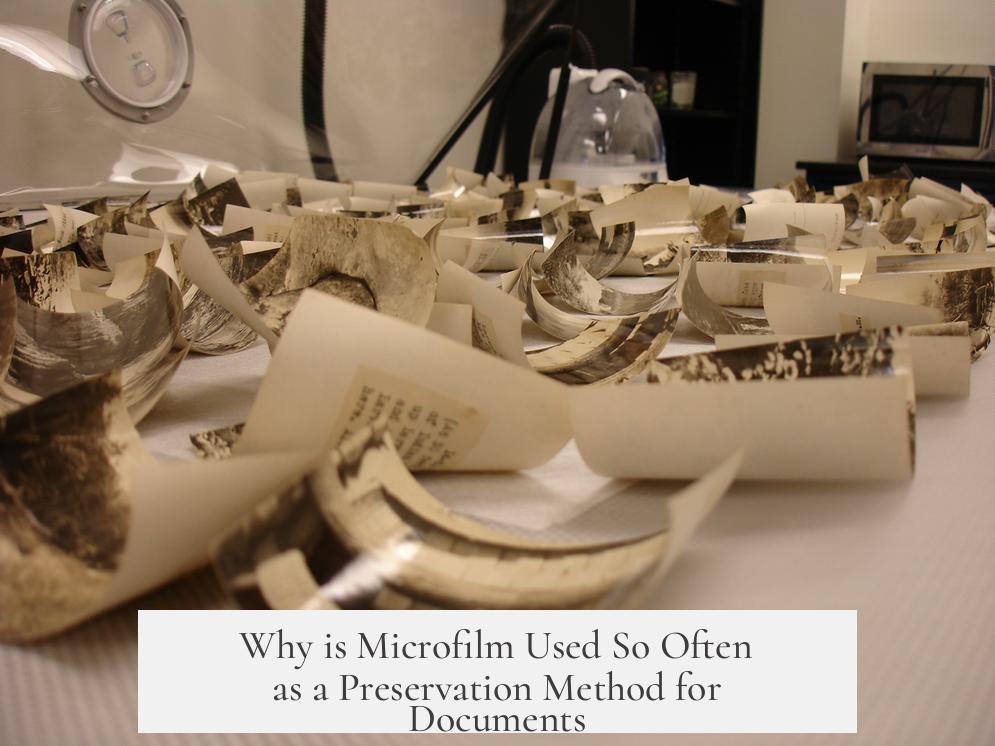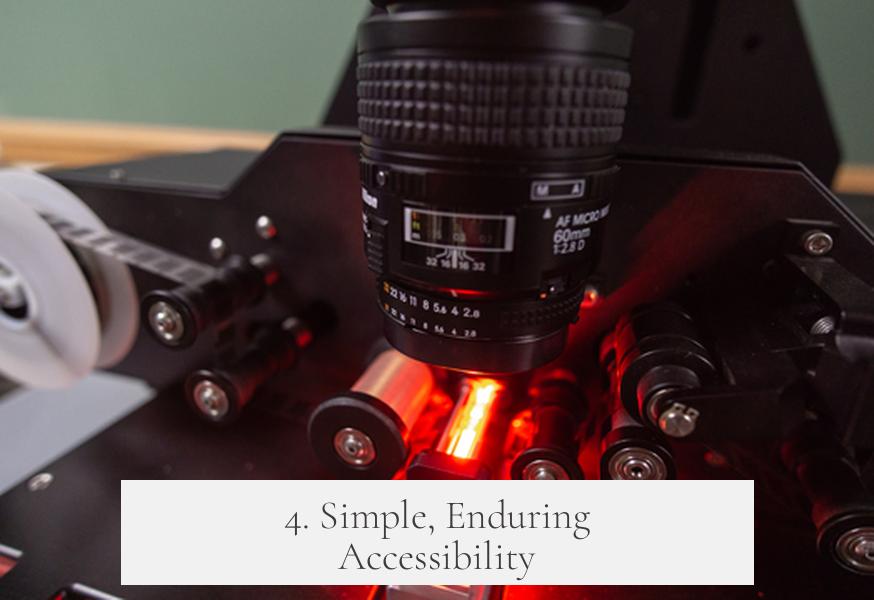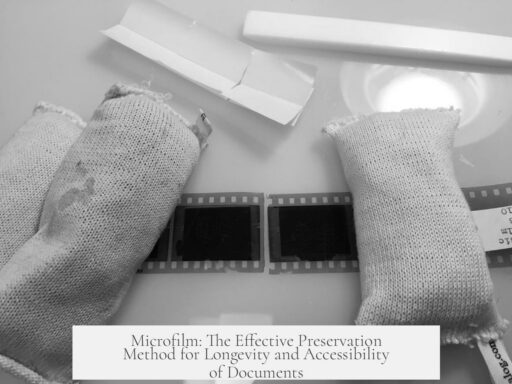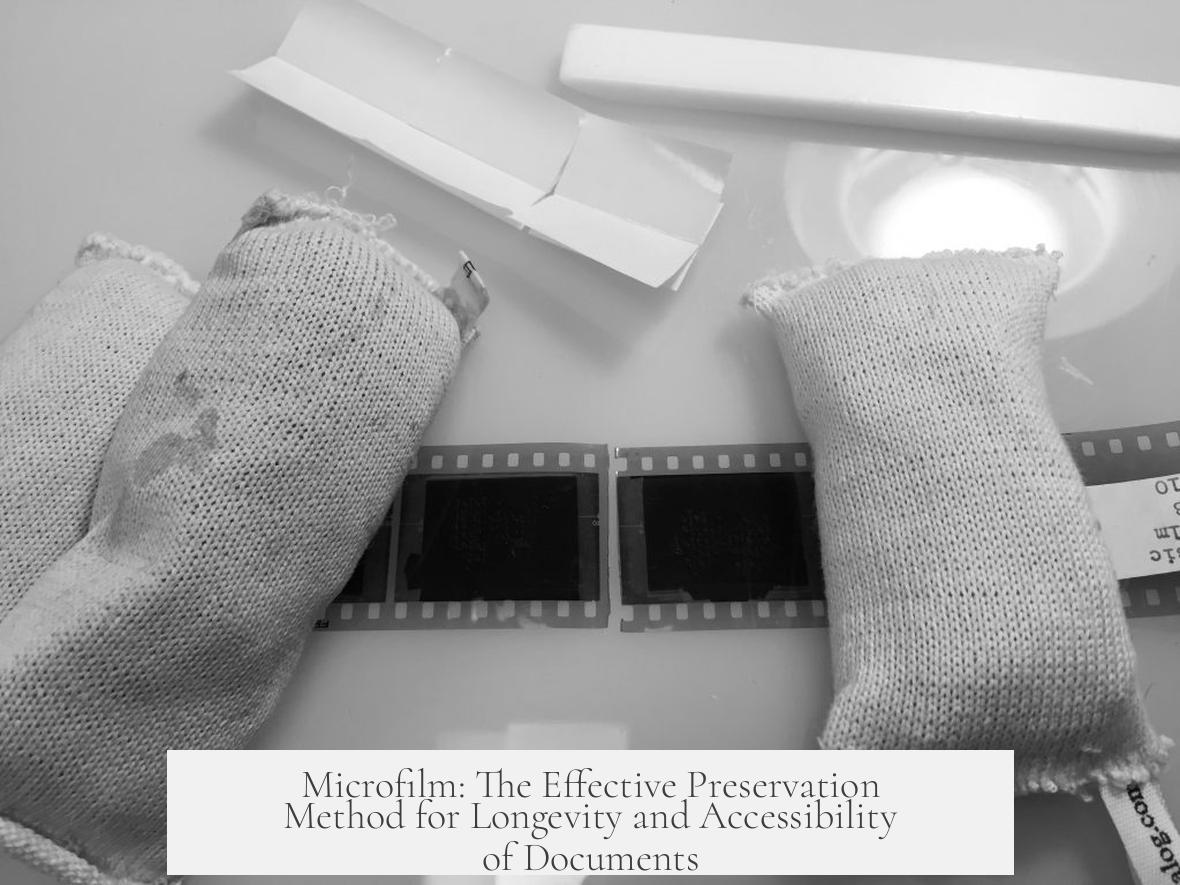Microfilm is widely used as a document preservation method due to its exceptional durability, stability, low cost, accessibility, and resilience against digital preservation challenges. It offers a reliable, long-term storage solution that suits both archival preservation and practical library use.
Polyester microfilm stands out for its remarkable longevity. Estimates suggest that properly stored microfilm can remain readable for 200 years, with some experts projecting lifespans up to 1000 years. This far surpasses typical paper documents and digital bitstreams, which are prone to faster degradation or obsolescence. Such longevity supports the preservation of documents for multiple generations.
Environmental stability makes microfilm ideal for archives with limited climate control. It handles fluctuations in temperature and humidity better than paper or digital formats. This reduces the need for costly and complex environmental management systems in storage areas, which is often not affordable for many institutions. Consequently, microfilm remains accessible even under less-than-ideal storage conditions.
- Compact size reduces physical storage space requirements significantly.
- Lightweight and small reels allow economical shipping, such as affordable interlibrary loans.
- Minimal maintenance costs; no need for power or expensive digital servers.
- Digitized or microfilmed documents from as early as the 1970s are still accessible today.
The accessibility of microfilm after decades is another major advantage. A microfilm created in the 1970s can be read with a microfilm reader, and newer reader models are still being developed. Even in simple, low-tech scenarios, such as using a flashlight against a white surface, a basic image can be retrieved. This practical aspect contrasts with digital archives, which often require continuous software upgrades, format migrations, and compatible hardware to access content.
Digital preservation faces several challenges that microfilm circumvents:
- High labor costs involved in digitizing documents.
- Ongoing subscription fees for content access through digital services.
- Frequent data migration needed due to rapid technological changes; typically every 2-3 years.
Microfilm avoids these issues by being a stable, single-format medium not dependent on specific software or hardware to read the data. There is no risk of sudden loss due to format obsolescence or subscription cancellations.
Microfilm also enables a clear preservation and access strategy. Archives often create two copies: a preservation master and an access copy. Its sturdiness makes microfilm preferable to older formats like microfiche or microcards, which were fragile or subject to damage. Microfilm reels can be duplicated easily and stored compactly, reducing chances of loss or damage over time.
From an archival management perspective, microfilm fits well with growing collections. Libraries and archives tend not to discard materials but accumulate them. A format that is compact, durable, and low-maintenance helps manage space effectively and reduces long-term handling requirements.
| Key Benefit | Description |
|---|---|
| Longevity | Decades to centuries lifespan under proper storage |
| Environmental Tolerance | Resists heat and humidity fluctuations |
| Low Cost | No ongoing electricity or server costs, affordable storage |
| Readability | Compatible with simple and improving reader technologies |
| Digital Independence | No need for continual data migration or subscriptions |
| Durability | Strong physical format, easy to copy and handle |
In summary:
- Microfilm’s long lifespan supports extended document retention.
- Stable under varying environmental conditions without costly controls.
- Compact, economical storage and transportation.
- Accessible with straightforward, evolving reader technology.
- Avoids digital preservation pitfalls like migration and subscription dependency.
- Supports archival practices with preservation and access copies.
- Manages growing collections efficiently and sustainably.
Why is Microfilm Used So Often as a Preservation Method for Documents?

Simply put, microfilm is favored for document preservation due to its unmatched longevity, durability, low cost, and accessibility—even when digital tech struggles or fails. Let’s dive into why archivists keep relying on this classic medium, despite living in a world dominated by pixels and cloud storage.
Think about it. History’s treasures, legal records, newspapers from decades ago—they all survive because someone wisely chose microfilm. Why? The answer lies in microfilm’s remarkable staying power and practical virtues.
How many options can outlive a paper document by centuries while being immune to floods, overheating, or even obsolete software? Not many. Microfilm fits this bill perfectly. Let’s explore this vintage hero of archival science.
1. Durability and Longevity of Microfilm: The Time Lord of Documents
If stored properly, polyester-based microfilm can last hundreds, even up to a thousand years. Compare that to your average printer paper that turns yellow and brittle in a few decades. Or digital files—those are at mercy of servers, hard drives, and constant software migrations.
“Microfilm has a half-life rated anywhere from a few hundred years, conservatively, to a millennium,” says preservation experts. That’s hundreds of years longer than most paper records or digital bitstreams.
This longevity means institutions can trust microfilm for generational preservation. A 1970s microfilm reel? Still perfectly readable today. That’s a luxury rarely matched by early digital archives, which often need continuous tech babysitting or risk being lost to obsolescence.
2. Survival Against Environmental Chaos
Archives aren’t always maintained in pristine, climate-controlled vaults. Some have to make do with less-than-ideal conditions, especially in budget-limited settings.
Microfilm laughs at fluctuations in temperature and humidity. It tolerates these gracefully, so even if the heating system breaks down in winter or humidity spikes during a wet season, the film survives. This resiliency cuts the costly need for expensive climate control in many archival stacks.
For archivists working on shoestring budgets, this means a reliable preservation medium without extravagant maintenance costs. It’s the archival equivalent of a rugged all-terrain vehicle amidst delicate race cars.
3. Space and Cost: Tiny Size, Big Savings
Ever wrestled with mountains of paper swallowing entire rooms? Microfilm solves that problem by being incredibly small and compact.
- One roll can store thousands of pages.
- Stacks take up minimal shelf space compared to paper volumes.
- Cheaper to mail and copy for interlibrary loans than heavy books or fragile originals.
Plus, microfilm requires practically no electricity or pricey server space like digital archives do. This makes it a cost-effective choice for cash-strapped archives.
Take Canada’s archival practice as an example—many original documents were microfilmed and then discarded, freeing up space while retaining the vital information in an accessible, smaller format.
4. Simple, Enduring Accessibility

Decades-old microfilm remains instantly accessible. No software updates, no apps necessary.
If the power grid dies tomorrow, you wouldn’t grab your dead laptop to access critical records. But pop in a microfilm reel, use a manual reader—or even a flashlight and a white wall if pressed—and you can read the documents.
And here’s a fun fact: Microform reader technology isn’t going extinct. In fact, it’s getting better, evolving with modern enhancements. So, accessibility stands the test of time.
Try that with a file stored on a long-obsolete format or locked behind paywalled subscriptions! With many digital archives, you might need specialized, expensive software, server maintenance, or labor-intensive format migration every few years.
5. No Tech Drama: Sidestepping Digital Preservation Pitfalls
Digital preservation has its downsides. Let’s not sugarcoat it:
- Copying digital documents takes labor and expertise.
- Libraries often don’t own digital content outright—subscriptions are required.
- Data migrations must occur every 2-5 years to prevent obsolescence.
- The risk of digital corruption and loss is nontrivial.
Microfilm avoids all this hassle. A stable, single-format physical copy exists that requires no software updates or costly subscriptions.
In fact, some institutions digitize from their microfilm copies rather than fragile originals. Microfilm acts as the “master record” before digital intermediaries get involved—protecting the data against tech volatility.
6. Physical Copies and Smart Backup Strategies
Unlike microfiche and microcards that could be flimsy and easy to misplace, microfilm is sturdy and designed for repeated handling.
Most archives keep two versions: a preservation copy (master) and an access copy. You use the access copy for research so the master remains safe, reducing the risk of damage.
Turn the reel, find your page, and print it off. Easy and reliable. This workflow ensures longevity and user convenience simultaneously.
In many research libraries, hefty microfiche collections still exist orderly, thanks to microfilm’s sturdiness. It replaced older formats that weren’t as practical or durable.
7. Practicality in Growing Archives
Librarians and archivists rarely throw things out—collections grow constantly.
Microfilm fits perfectly into this perpetual growth. It’s compact enough to “put on a shelf and forget,” requiring minimal upkeep.
This is vital because continually expanding archives can quickly become unmanageable if using bulky paper or high-maintenance digital files.
Microfilm’s low maintenance and scalability save time, space, and effort, letting archivists focus on collection development instead of storage crises.
Summary: Why Microfilm Keeps Winning the Preservation Race
| Key Reason | Benefit |
|---|---|
| Extreme Longevity | Lasts hundreds to thousands of years if properly stored |
| Environmental Stability | Tolerates heat and humidity swings; no expensive climate control needed |
| Low Cost & Space Efficient | Small size reduces storage costs and physical space |
| Long-Term Readability | Use simple equipment to access decades-old records easily |
| Avoids Digital Hassles | No need for ongoing data migration, subscriptions, or software updates |
| Durable Physical Backups | Strong enough for reuse, with preservation vs access copies |
| Supports Growing Archives | Compact, low-maintenance format that scales with collections |
In short, microfilm shines because it solves real-world archival problems with time-tested solutions. It’s a perfect blend of old-school durability and practical economy in document preservation.
So, next time you stumble across a dusty microfilm reel, remember: that little spool holds centuries of history—safe, sound, and ready for your strong flashlight or microfilm reader to unlock its secrets.
Isn’t it funny how sometimes, looking backward preserves the future?
Why does microfilm last longer than paper or digital files?
Microfilm, especially polyester-based, can last several hundred years up to 1000 years if stored right. Paper deteriorates faster, and digital files require constant updates to remain accessible.
How does microfilm handle changes in temperature and humidity?
Microfilm tolerates swings in heat and moisture better than many materials. Archives without advanced climate control benefit since microfilm remains stable and readable despite environmental changes.
Why is microfilm cheaper to store than digital archives?
Microfilm occupies very little space and needs no electricity or servers. Digital archives require costly infrastructure and constant upkeep, while microfilm can be stored cheaply with minimal maintenance.
Is microfilm still easy to access compared to digital formats?
Yes. Microfilm readers are still made and improving. You don’t need complex software. Even simple setups can read microfilm, ensuring information remains available over decades.
How does microfilm avoid problems common in digital preservation?
It does not need data migration or costly subscriptions. Digital files risk loss through format changes or license issues. Microfilm remains readable without software dependencies or ongoing fees.
What makes microfilm better than older physical preservation methods?
Microfilm is sturdy, compact, and easily copied. It replaced fragile formats like microfiche and microcards, offering a more reliable way to keep preservation and access copies safe over time.




